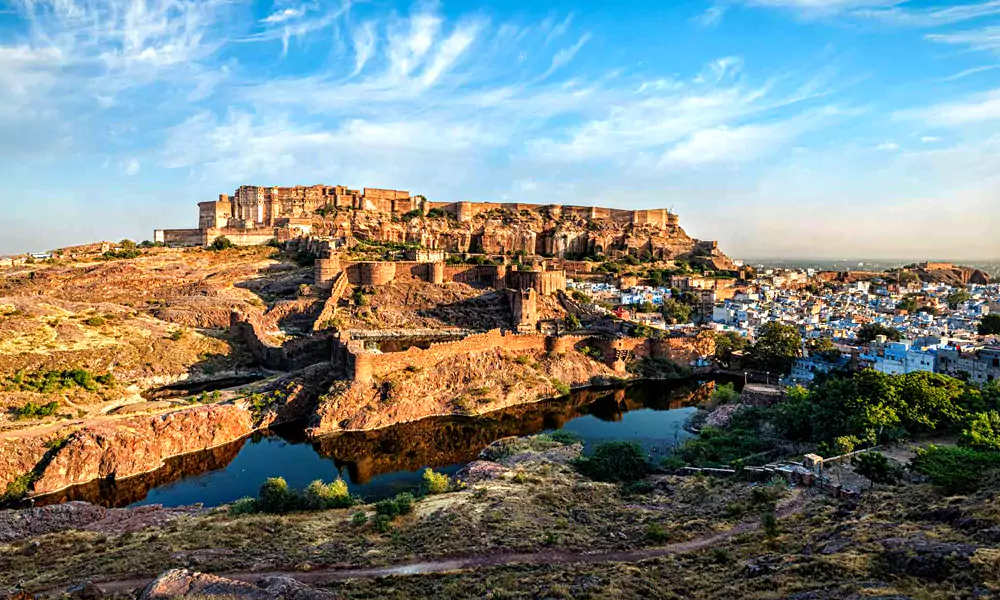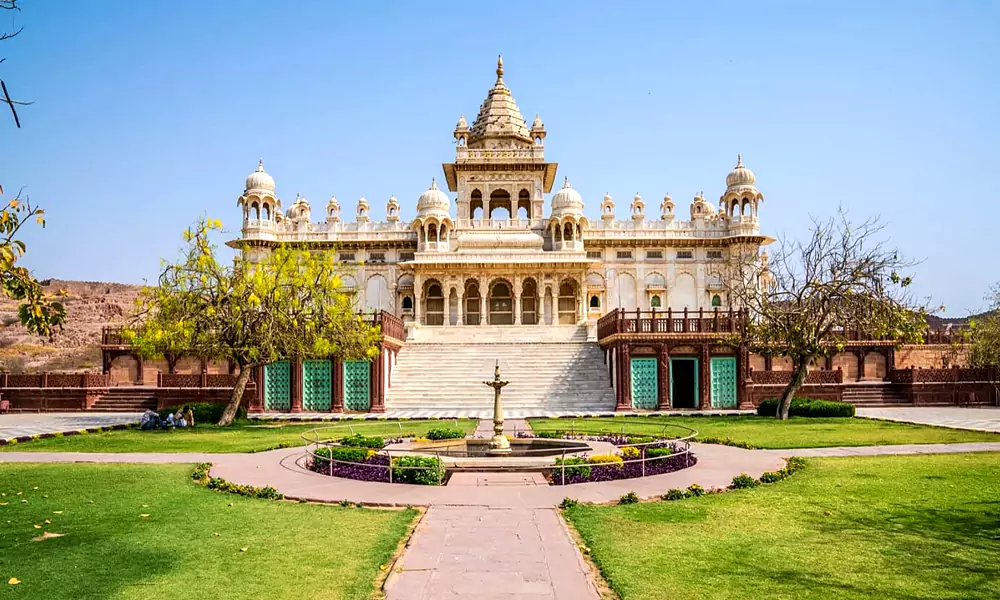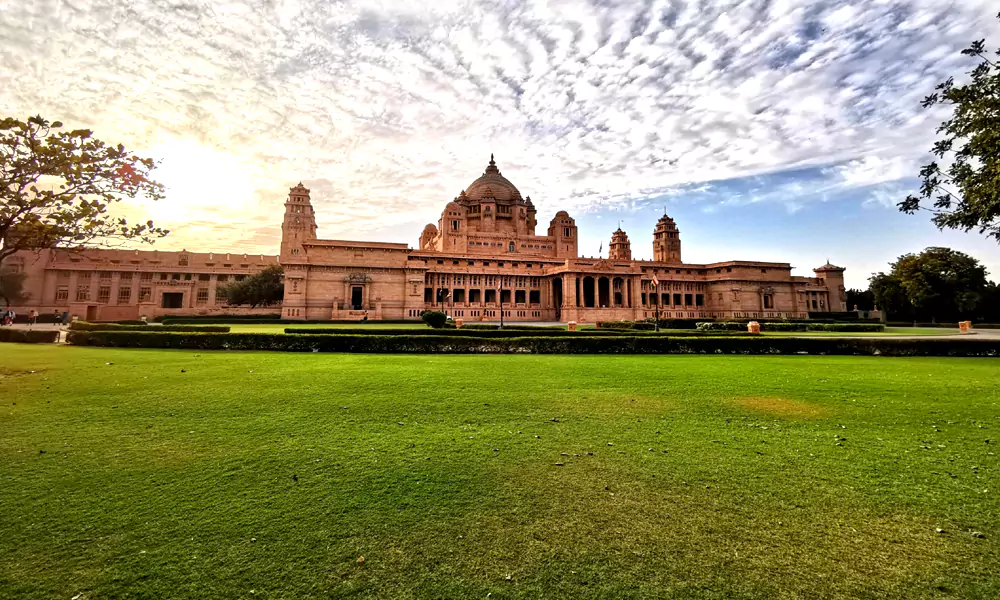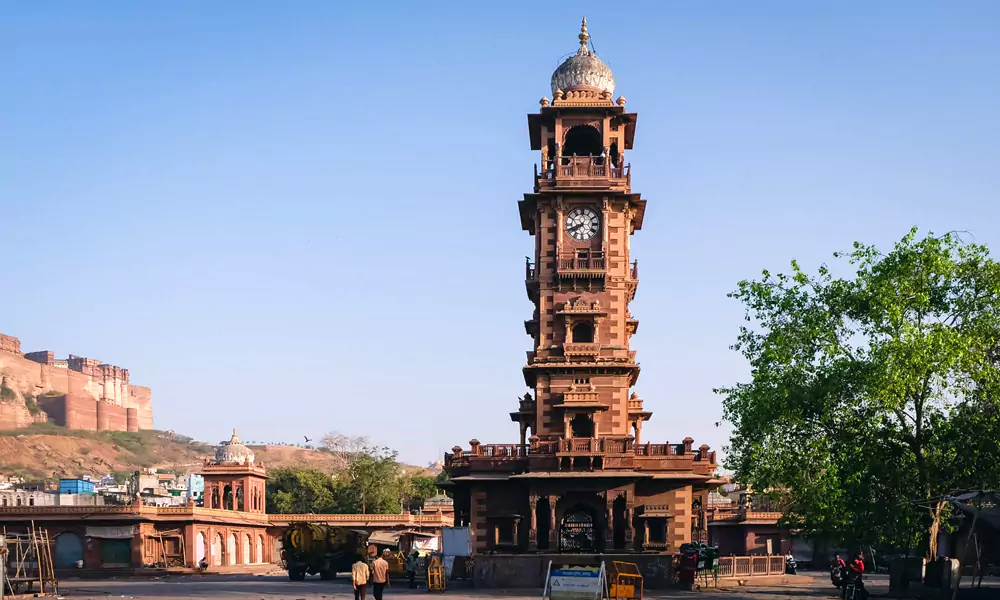
Rajasthan, the land of kings, is renowned for its majestic forts and palaces that stand as testaments to its rich history and vibrant culture. Among these architectural marvels, Mehrangarh Fort in Jodhpur holds a special place. Perched on a rocky hill, 400 feet above the city, Mehrangarh Fort is one of the largest and most well-preserved forts in India. Its imposing structure, intricate carvings, and panoramic views make it a must-visit destination for history enthusiasts and travellers alike.
Timings and Entry Fee
Mehrangarh Fort is open to the public every day from 9:00 AM to 5:00 PM. The fort and its attractions advise visitors to allocate sufficient time for exploration. The entry fee for Indian visitors is approximately INR 100 for adults and INR 50 for students, while for foreign tourists, the fee is around INR 600. Charges apply for camera usage and guided tours, which are highly recommended for gaining deeper insights into the fort’s history and significance.
History of Mehrangarh Fort
Foundation and Early Years
Rao Jodha, the fifteenth ruler of the Rathore dynasty, founded Mehrangarh Fort as a new capital for the Marwar kingdom in 1459 AD. He chose to replace the old and less secure capital of Mandore with this fort. According to legend, Rao Jodha laid the foundation of Mehrangarh Fort on the advice of a hermit named Chidiya Nathji, who lived on the rocky hill known as Bhakurcheeria, or the Mountain of Birds.
Expansion and Fortifications
Over the centuries, Mehrangarh Fort witnessed numerous expansions and fortifications by successive rulers. The fort’s strategic location and formidable defences made it a significant stronghold in Rajasthan. The fort complex grew to include palaces, temples, courtyards, and walls that stretched for miles. Each ruler left his mark on the fort, contributing to its unique blend of architectural styles and historical significance.
Architecture of Mehrangarh Fort
Imposing Gates
Seven imposing gates have led to Mehrangarh Fort, each with its own historical and architectural significance. The main entrance, known as Jai Pol (Gate of Victory), was built by Maharaja Man Singh in 1806 to commemorate his victory. The armies of Jaipur and Bikaner were defeated. Other notable gates include Fateh Pol (Gate of Victory), Loha Pol (Iron Gate), and Dedh Kangra Pol (Gate of Deceit), each narrating tales of valour and triumph.
Palatial Complexes
The palaces, displaying the opulence and grandeur of Rajput architecture, greet visitors within the fort. The most prominent palaces include:
- Moti Mahal (Pearl Palace): Known for its stunning glass windows and intricately carved panels, Moti Mahal was the coronation hall of the Rathore rulers. The palace’s ceiling is adorned with gold leaf and mirror work, creating a mesmerizing effect.
- Phool Mahal (Flower Palace): Built by Maharaja Abhaya Singh in the 18th century, Phool Mahal is the most ornate palace in Mehrangarh Fort. The hall features lavish decorations, including gold filigree work, vibrant frescoes, and exquisite floral patterns.
- Sheesh Mahal (Mirror Palace): As the name suggests, Sheesh Mahal is adorned with mirror work that reflects light in a dazzling display. The palace also features intricate paintings depicting various Hindu deities and mythological scenes.
Intricate Carvings and Decorations
Intricate carvings and detailed decorations adorn the walls, pillars, and ceilings of Mehrangarh Fort, making it renowned. The fort’s architecture seamlessly blends Rajput and Mughal styles, showcasing the artistic prowess of the craftsmen of that era. The delicate latticework, jharokhas (overhanging enclosed balconies), and chhatris (elevated pavilions) add to the fort’s aesthetic appeal.
Significance of Mehrangarh Fort
Cultural and Historical Importance
Mehrangarh Fort holds immense cultural and historical significance for the people of Rajasthan. It serves as a symbol of the Rathore dynasty’s resilience, valour, and architectural brilliance. The fort has witnessed numerous battles, celebrations, and significant events in Rajasthan’s history, making it a living museum of the region’s heritage.
Preservation and Restoration
The efforts of the Mehrangarh Museum Trust have preserved and restored the fort meticulously over the years. Established in 1972 by Maharaja Gaj Singh II, the trust has played a crucial role in maintaining the fort’s structural integrity and showcasing its rich history to the world. The museum within the fort houses a vast collection of artefacts, including royal costumes, weaponry, paintings, and manuscripts, offering visitors a glimpse into the royal lifestyle of the Rathore rulers.
Cultural Events and Festivals
Mehrangarh Fort is not just a historical monument; it is also a vibrant cultural hub. The fort hosts various cultural events and festivals throughout the year, attracting artists, performers, and tourists from around the globe. One of the most prominent events is the Rajasthan International Folk Festival (RIFF), held annually in October. The festival celebrates Rajasthan’s folk music, dance, and arts, creating a lively and immersive experience for visitors.
Exploring Mehrangarh Fort
Audio Guides and Guided Tours
To enhance the visitor experience, Mehrangarh Fort offers audio guides and guided tours that provide detailed insights into the fort’s history, architecture, and significance. The audio guides are available in multiple languages, allowing visitors to explore the fort at their own pace while learning about its rich heritage.
Key Attractions within the Fort
- Chamunda Mataji Temple: Situated within the fort complex, this temple is dedicated to Chamunda Mata, the patron goddess of the Rathore dynasty. The temple attracts devotees and tourists alike, offering panoramic views of Jodhpur city.
- Daulat Khana (Treasury): This section of the fort houses a remarkable collection of artefacts, including arms, armour, textiles, paintings, and manuscripts. The exhibits provide a fascinating glimpse into the opulent lifestyle of the Rathore rulers.
- Zenana Deodi (Queen’s Palace): The Zenana Deodi is a secluded area within the fort where the royal women reside. The palace features beautiful jali (lattice) work and exquisite frescoes, offering a glimpse into the lives of the royal women.
- Rao Jodha Desert Rock Park: Located adjacent to the fort, this park is a conservation area that showcases the natural flora of the region. The park offers scenic walking trails, providing visitors with an opportunity to explore the unique desert landscape.
Best Time to Visit Mehrangarh Fort
The best time to visit Mehrangarh Fort is during the winter months, from October to March when the weather is pleasant and conducive to sightseeing. The scorching summer heat of Rajasthan can be overwhelming, making winter the ideal season to explore the fort and its surroundings.
How to Reach Mehrangarh Fort
By Air
The nearest airport to Mehrangarh Fort is Jodhpur Airport, located approximately 8 kilometres away. The airport is well-connected to major cities in India, including Delhi, Mumbai, and Jaipur. From the airport, visitors can hire a taxi or take a pre-arranged transfer to reach the fort.
By Train
Jodhpur Railway Station is the nearest railhead to Mehrangarh Fort, situated about 5 kilometres from the fort. The station is well-connected to major cities in India, including Delhi, Mumbai, Jaipur, and Ahmedabad. From the railway station, visitors can hire a taxi or take an auto-rickshaw to reach the fort.
By Road
Jodhpur is well-connected by road to major cities in Rajasthan and neighbouring states. State-run buses, private buses, and taxis are available for travel to Jodhpur. Visitors can also opt for self-drive or rental cars to reach Mehrangarh Fort.
Nearby Attractions
1. Jaswant Thada

Located a short distance from Mehrangarh Fort, Jaswant Thada is a beautiful marble cenotaph built in memory of Maharaja Jaswant Singh II. The cenotaph features intricate marble lattice work, domes, and a tranquil garden, making it a serene spot to visit.
2. Umaid Bhawan Palace

Umaid Bhawan Palace, one of the largest private residences in the world, is another must-visit attraction in Jodhpur. The palace, a blend of Indian and European architectural styles, is partially open to the public as a museum. It showcases artefacts, photographs, and vintage cars, offering a glimpse into the royal history of Jodhpur.
3. Clock Tower and Sardar Market

For a taste of local life, visitors can explore the bustling Clock Tower and Sardar Market in the heart of Jodhpur. The market is a vibrant hub of activity, with shops selling spices, textiles, handicrafts, and souvenirs. The iconic Clock Tower stands as a landmark in the market area, adding to the charm of the place.
Travel Tips
- Wear Comfortable Footwear: Exploring Mehrangarh Fort involves a fair amount of walking, including climbing stairs and navigating uneven surfaces. Comfortable footwear is essential for a pleasant visit.
- Stay Hydrated: Jodhpur’s climate can be quite hot, especially during the summer months. Carry a water bottle and stay hydrated while exploring the fort and other attractions.
- Respect Local Customs: When visiting temples and other religious sites within the fort, dress modestly and respect local customs. Remove your shoes before entering temples and avoid inappropriate behaviour.
- Photography Tips: Mehrangarh Fort offers numerous photo opportunities, from panoramic views of the city to intricate architectural details. Bring a good camera and take your time capturing the fort’s beauty. Early morning or late afternoon provides the best lighting for photography.
Frequently Asked Questions (FAQs)
Yes, Mehrangarh Fort is open to visitors every day from 9:00 AM to 5:00 PM. However, it’s advisable to check for any changes in timings or special closures due to events.
Yes, there is an entry fee for visiting Mehrangarh Fort. The fee varies for Indian and foreign tourists, with additional charges for camera use. It’s recommended to check the official website for the latest fee structure.
Yes, you can hire a guide at Mehrangarh Fort. Guided tours are available in multiple languages, providing detailed insights into the fort’s history and architecture. Audio guides are also available for a self-guided tour.
Yes, there are a few cafes and eateries within the fort complex where you can enjoy refreshments and snacks. The Chokelao Mahal Terrace is a popular spot, offering a delightful dining experience with stunning views of the fort and the city.
While some areas of the fort may be challenging for wheelchair access due to stairs and uneven surfaces, efforts have been made to improve accessibility. It’s advisable to check with the fort authorities for specific information on accessible routes and facilities.
Conclusion
Mehrangarh Fort, with its majestic presence and rich historical significance, is a must-visit destination for anyone exploring Rajasthan. The fort’s stunning architecture, fascinating history, and cultural heritage provide a captivating experience. From the impressive palaces and temples to the breathtaking views of Jodhpur, Mehrangarh Fort offers a glimpse into the grandeur of Rajputana. Whether you are a history enthusiast, an architecture lover, or simply seeking an unforgettable travel experience, Mehrangarh Fort promises to leave you spellbound with its timeless beauty and regal charm.
